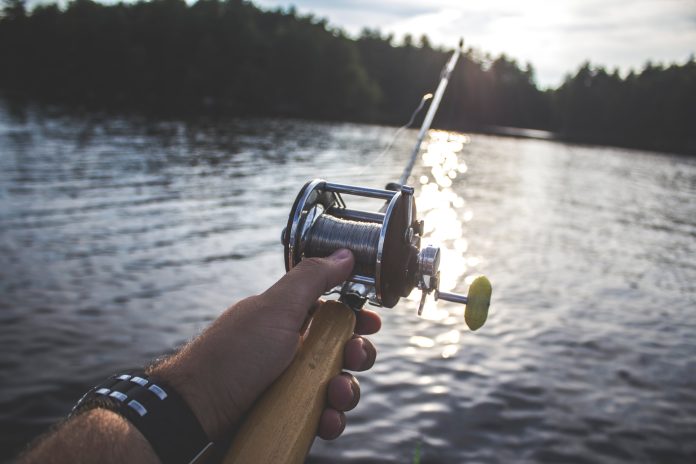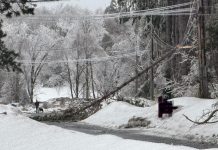With summer in full swing, many Muskoka residents are spending time on the lake with a line in the water. Occasionally, anglers may find they’ve got the wrong kind of critter on their hook, but there are steps they can take to save any accidentally hooked turtles.
Over 1.5 million anglers fish in Ontario every year, according to a 2015 government survey. Their time on the water adds up to 74.6 million hours of fishing, so naturally, turtle encounters are bound to occur, said Kelly Wallace, founder and managing director of the Think Turtle Conservation Initiative. Many fishermen simply cut the line after hooking a turtle, but it’s an approach that can affect a turtle’s ability to forage for food and cause disease or infection. Luckily, there are better ways to solve the problem as well as ways to help reduce encounters in the first place.
“It is an inescapable fact that with every fishing line cast into Ontario’s 250,000 lakes,100,000 kilometres of rivers and other waterways there is the distinct possibility of accidentally hooking a turtle, being that this is the natural habitat to turtles as well as fish,” Wallace said. “To reduce the chances of hooking a turtle and ideally avoid [it], it is helpful to be particularly mindful about the location you choose to fish, the bait used and gear modifications.”
While it’s great to know prime fishing spots, it’s important to consider where turtles are common as well. If turtles are basking nearby or the fishing spot is near heavy vegetation, anglers should be mindful of turtles crossing their path. It’s even better if they can adjust their location to a spot where turtles appear less frequently.
In addition, turtles are attracted to live bait, so consider using lures, which are less appetizing to turtles and discourage them from taking an interest in the hook. Barbless hooks also reduce the chance of hooking a turtle and causing serious injuries. If an angler does hook a turtle, the first step is getting it out of the water safely.
Slowly reel in the slack line to bring the turtle closer and before the line is taut, use a net or carefully grab the back of the shell to remove the turtle from the water. Never lift the turtle using the fishing line or by their tail since both actions can cause serious injury, and stay alert since the animal will likely be panicked.
“Once the turtle is safely out of the water and with you, the fishing line can be cut so the hook can be removed,” Wallace said. “Please make sure to leave at least one foot of line past the mouth and secure the line to prevent the turtle from swallowing the line.”

One person may be able to remove the hook from a small turtle, but it often helps to have two people, and it’s necessary for larger species like snapping turtles. One person can hold the turtle while the other works to remove the hook.
Anglers who have hooked snapping turtles recommend wrapping them in a shirt or towel to contain their limbs and calm them down during hook removal. Snappers are strong, so it’s essential to keep fingers and other body parts out of reach from their long necks.
For barbless hooks, needle nose pliers usually work for removal, Wallace said. As anglers grasp the hook, they should curve it back the way it went in. For barbed or semi-barbed hooks, do not attempt removal unless it’s easy to cut off the barbed end. If an angler isn’t comfortable removing the hook or hasn’t been able to get it out, it’s crucial for them to contact a vet, a wildlife rehabber or the Ontario Turtle Conservation Centre (OTCC) for help.
The OTCC is home to Ontario’s turtle hospital and takes in thousands of turtles every year. Though road mortality is the most common reason for admission, many of the turtles they take in have evidence of a hook or fishing line swallowed at some point, raising concerns about the total number of turtles injured or killed by hooks and lines each year.
“There is no way to determine how many turtles are accidentally hooked on fishing lines and returned to the water with a hook intact each year in Ontario,” Wallace said. “However, when talking with anglers, it is evident that the number of turtles accidentally hooked and returned to the water annually is far greater than the number of turtles admitted to the OTCC with fishing-related injuries.”
For anglers and other nature lovers who come across an injured turtle, it’s important to call the OTCC at 705-741-5000 as soon as possible. The turtle hospital will arrange transportation for the turtle and take care of all medical needs at their centre in Peterborough, along with offering guidance for how to care for it in the meantime.
The eight turtle species in Ontario are designated as species at risk and are in crisis, Wallace said, so raising awareness for the different hazards they face is essential to their survival. Reducing fishing-related injuries and fatalities is a crucial part of addressing the province’s declining turtle population.
“Ontario’s turtles cannot sustain losses to any degree. Even what is perceived as low levels of turtle mortality are sufficient enough to impact localized and provincial turtle populations,” she said. “Safeguarding turtles from harm is integral to species recovery efforts aimed at helping return this most vulnerable species back to their former healthy populations.”
To learn more, check out Think Turtle Conservation Initiative’s website. For other turtle related questions, call or text Think Turtle at 647-606-9537.








